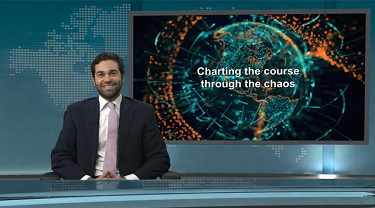Worried? Well, maybe you should be. EDC Economics’ Top 10 Global Risks is aimed at focusing exporters on the possible threats that should be of greatest concern. Risk mitigation is key to addressing some of these risks that may be on your radar.
Change is an omnipresent mantra, ranging from disruptive technologies, like artificial intelligence to the varied impacts of climate change. One consequence of the pace of change is that citizens from Brazil to Hungary are electing populist governments and providing them with a mandate to upend the status quo contributing to increased Global Protectionism. One glaring manifestation of this No. 1 risk is the current trade war between the United States and China, which is not only having repercussions on both economies, but also pumping the brakes on worldwide growth. If it escalates, it could have long-term effects on future investment, global supply chains and trade flows.
While any change in the international trading system would be costly for Canadian companies, most eyes remain transfixed on our neighbour to the south. The risk of Fortress America has dropped to No. 2 given the U.S., Canada and Mexico signing of a new trade agreement toward the end of 2018. However, the renegotiated Canada-United States-Mexico Agreement (CUSMA) has yet to be ratified by member governments, and tariffs remain in place on Canadian steel-and-aluminum exports.
Traditionally, the U.S. has been the stalwart and at times, the sole engine of global growth, however, there’s growing concern that a self-inflicted Global Recession could be coming. While we maintain that growth fundamentals are strong, some current international trade policies are interrupting planet-wide investment plans, crucial to securing future growth.
Moving up our list this year is the risk surrounding Brexit, and specifically the likelihood of no agreement being reached on the impending withdrawal of the United Kingdom from the European Union by the end of March. As the window for a deal closes rapidly, uncertainty is rising and the possibility of a chaotic exit or a delay is growing. For Canadian exporters, this raises key questions such as maintaining access to the U.K. market and the sustainability of agreements with the EU. Companies are already having to put their contingency plans into action.
The risk of U.S. isolationism that produces a geopolitical void is moving closer to reality as America withdraws from its global leadership position. On countless issues—from trade (TPP) to the environment (Paris Agreement) to security (NATO)—Washington has indicated it would take a different approach. This has immediate impacts for Canadian companies, as previously our values and interests were championed by the U.S. Canada may face a future where we must go it alone or find other allies on issues important to us.
If geopolitics is facing challenges to the status quo, the global economy is also moving into uncharted waters as central banks continue withdrawing all the extra quantitative easing cash they pushed out into the world.
Countries that took on too much debt when liquidity was high, now face being over-leveraged and unable to meet their debt payment obligations. In 2018, we saw what can happen to economically weak countries, like Turkey and Argentina, which over-relied on cheap financing. The question now is whether this is contained or ushering a wave of sovereign emerging market defaults.
China’s credit/financial crisis: China’s debt for some time now has been growing rapidly. It contends that its strong growth outlook for 2019 results from a rebalancing of the economy and from the government’s reform program, rather than from a reliance on debt. And, in fact, China’s regulators are looking to curb their unmonitored, shadow-banking sector, in order to address imbalances in the financial system. If this process of tightening financial conditions isn’t properly managed, however, it could have negative effects on other sectors of China’s economy, and possibly on Canadian companies doing business there.
One risk that has remained on our list for the past few years is the threat of a large cyber-attack. With precedents now in the U.S., France and the U.K., among others, the risk of foreign interference into Canada’s elections in October is a key risk on policymakers’ minds. Canadian companies are also on alert: the Canadian Internet Registration Authority reports that 88% of respondents to its 2018 security survey are worried about the prospect of future cyber-attacks, as the average cost of a breach last year was US$3.86 million.
With America’s evolving role in international affairs, the guardrails put in place to ensure stability are weakening. There is no longer one arbiter to keep things in check. The risk of Inter-State war speaks to these preconditions, which EDC Economics believes increase the probability of conflict, whether that be in the South China Sea, or between the West and Russia. While conflict on the Korean Peninsula has fallen off our list due to diplomatic efforts, this theatre may re-ignite quickly.
Rounding out our Top 10 list and a new addition is EU fragmentation. The mood across European capitals is one of concern. Europe’s strongest leader over the past decade, Germany’s Angela Merkel, is moving on; French President Emmanuel Macron is engulfed by domestic protests; the U.K. is immobilized by Brexit. If another Greek financial crisis were to emerge today, who would lead the charge to calm markets and implement a rescue plan?
The bottom line?
The list is scary, but it doesn’t do any good to hide from it. Best to manage through a turbulent time and have contingency plans in the event that any of these threats turns into reality–including international financial risk mitigation, EDC’s specialty.
This commentary is presented for informational purposes only. It’s not intended to be a comprehensive or detailed statement on any subject and no representations or warranties, express or implied, are made as to its accuracy, timeliness or completeness. Nothing in this commentary is intended to provide financial, legal, accounting or tax advice nor should it be relied upon. EDC nor the author is liable whatsoever for any loss or damage caused by, or resulting from, any use of or any inaccuracies, errors or omissions in the information provided.





